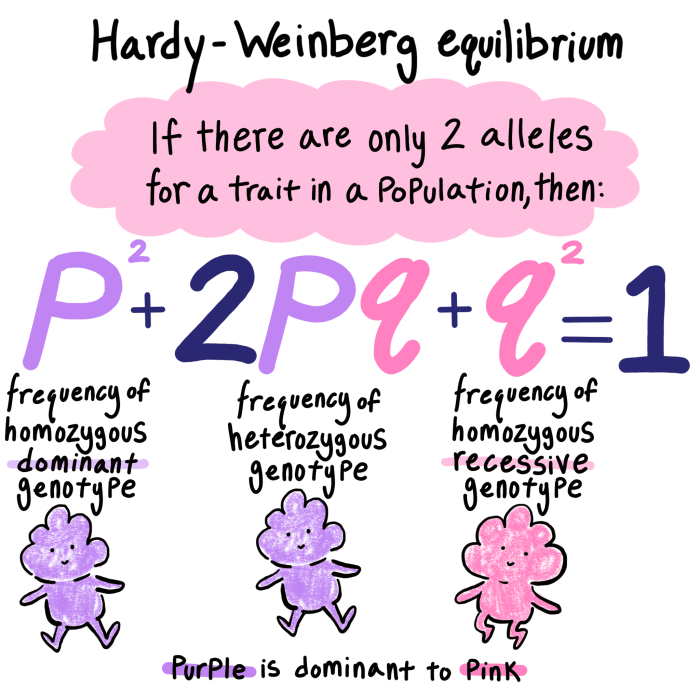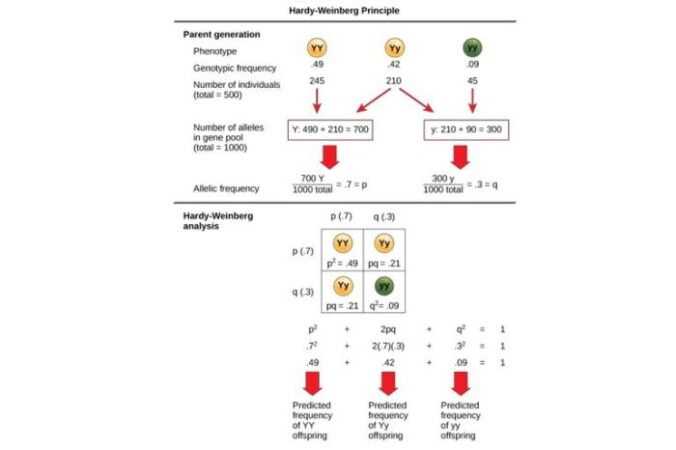What is hardy weinberg law – What is the Hardy-Weinberg Law? It’s a fundamental principle in population genetics that describes how allele and genotype frequencies remain stable in a population over generations, assuming certain conditions are met. This principle acts as a baseline for understanding how evolutionary forces, like mutations, gene flow, and natural selection, can alter genetic makeup over time.
The Hardy-Weinberg principle rests on five key assumptions: a large population size, random mating, no mutations, no gene flow, and no natural selection. These assumptions are rarely met in real-world scenarios, making the Hardy-Weinberg principle a theoretical model rather than a perfect reflection of reality. However, its importance lies in its ability to provide a reference point for comparing real populations and understanding the processes that drive genetic change.
Introduction to Hardy-Weinberg Principle

The Hardy-Weinberg principle, also known as the Hardy-Weinberg equilibrium, is a fundamental concept in population genetics. It describes the theoretical conditions under which allele and genotype frequencies in a population remain constant from generation to generation. This principle serves as a baseline against which to compare real-world populations, allowing us to understand the forces that drive evolutionary change.
Genetic Equilibrium
The Hardy-Weinberg principle describes the state of genetic equilibrium, where allele and genotype frequencies remain stable over time. This equilibrium occurs when there is no evolutionary pressure acting on the population. In other words, the population is not evolving. The principle provides a null hypothesis for population genetics, allowing us to identify deviations from equilibrium that indicate evolutionary forces are at work.
Assumptions of the Hardy-Weinberg Principle
The Hardy-Weinberg principle relies on five key assumptions:
- No mutations: Mutations are changes in the DNA sequence that can introduce new alleles into a population. If mutations occur at a significant rate, they can disrupt the equilibrium.
- Random mating: Individuals in the population must mate randomly, without any preference for specific genotypes. Non-random mating, such as assortative mating, can alter allele and genotype frequencies.
- No gene flow: Gene flow is the movement of alleles between populations. If there is significant gene flow, it can alter the allele frequencies in the recipient population.
- No genetic drift: Genetic drift is the random fluctuation of allele frequencies due to chance events, particularly in small populations. It can lead to the loss or fixation of alleles, disrupting equilibrium.
- No natural selection: Natural selection is the differential survival and reproduction of individuals based on their traits. If natural selection is acting on a population, it will favor certain alleles, leading to changes in allele frequencies.
Real-World Applications
The Hardy-Weinberg principle is a theoretical model, and real-world populations rarely meet all of its assumptions. However, it provides a valuable tool for understanding evolutionary processes. Some real-world applications include:
- Estimating allele frequencies: The Hardy-Weinberg principle can be used to estimate the frequencies of alleles in a population, even if we don’t know the genotypes of all individuals. This information can be used to track changes in allele frequencies over time and to identify populations that are undergoing evolutionary change.
- Testing for evolutionary forces: By comparing observed allele and genotype frequencies to those predicted by the Hardy-Weinberg principle, we can identify populations that are not in equilibrium and infer the evolutionary forces that are acting on them.
- Understanding genetic diseases: The Hardy-Weinberg principle can be used to understand the inheritance patterns of genetic diseases. For example, it can be used to predict the frequency of carriers for a recessive disease in a population.
Hardy-Weinberg Equations

The Hardy-Weinberg principle provides a framework for understanding how allele and genotype frequencies change over time in a population. To use this principle, we need to be able to calculate these frequencies. The Hardy-Weinberg equations provide a mathematical basis for doing so.
The Hardy-Weinberg equations are based on the idea that the frequencies of alleles and genotypes in a population will remain constant from generation to generation if certain conditions are met. These conditions are:
– No mutations
– No gene flow
– Random mating
– No genetic drift
– No natural selection
Calculating Allele Frequencies
Allele frequencies represent the proportion of each allele within a population. The Hardy-Weinberg principle uses the following equation to calculate allele frequencies:
p + q = 1
where:
– p represents the frequency of the dominant allele
– q represents the frequency of the recessive allele
For example, if we are considering a population with two alleles for a particular gene, let’s say allele ‘A’ and allele ‘a’, then the frequency of allele ‘A’ (p) plus the frequency of allele ‘a’ (q) must equal 1.
Calculating Genotype Frequencies
Genotype frequencies represent the proportion of each genotype within a population. The Hardy-Weinberg principle uses the following equation to calculate genotype frequencies:
p2 + 2pq + q2 = 1
where:
– p2 represents the frequency of the homozygous dominant genotype (AA)
– 2pq represents the frequency of the heterozygous genotype (Aa)
– q2 represents the frequency of the homozygous recessive genotype (aa)
For example, if the frequency of allele ‘A’ (p) is 0.7 and the frequency of allele ‘a’ (q) is 0.3, then the frequencies of the three genotypes would be:
– AA (p2) = 0.72 = 0.49
– Aa (2pq) = 2 * 0.7 * 0.3 = 0.42
– aa (q2) = 0.32 = 0.09
Predicting Allele and Genotype Frequencies
The Hardy-Weinberg equations can be used to predict allele and genotype frequencies in a population under specific conditions. For example, if we know the frequency of the homozygous recessive genotype (aa), we can use the Hardy-Weinberg equations to calculate the frequencies of the other genotypes and alleles.
Hypothetical Scenario, What is hardy weinberg law
Imagine a population of 100 butterflies with two alleles for wing color: black (B) and white (b). The black allele is dominant, so butterflies with at least one B allele have black wings. We observe that 16 butterflies have white wings (bb genotype).
1. Calculate the frequency of the recessive allele (q):
– Since 16 butterflies out of 100 have white wings, the frequency of the bb genotype (q2) is 16/100 = 0.16.
– To find the frequency of the recessive allele (q), we take the square root of q2: √0.16 = 0.4.
2. Calculate the frequency of the dominant allele (p):
– Using the equation p + q = 1, we can find the frequency of the dominant allele (p): p = 1 – q = 1 – 0.4 = 0.6.
3. Calculate the frequencies of the other genotypes:
– The frequency of the homozygous dominant genotype (BB) is p2 = 0.62 = 0.36.
– The frequency of the heterozygous genotype (Bb) is 2pq = 2 * 0.6 * 0.4 = 0.48.
Therefore, in this population, the expected allele and genotype frequencies are:
– Allele frequencies:
– p (B) = 0.6
– q (b) = 0.4
– Genotype frequencies:
– BB = 0.36
– Bb = 0.48
– bb = 0.16
Summary: What Is Hardy Weinberg Law

The Hardy-Weinberg principle is a powerful tool for understanding the dynamics of genetic variation in populations. While it is a theoretical model, its application in real-world scenarios has been invaluable in studying human populations, conservation biology, and the spread of genetic diseases. By understanding the factors that can disrupt Hardy-Weinberg equilibrium, we gain valuable insights into the mechanisms of evolution and the forces that shape the genetic makeup of life on Earth.
Question Bank
What is the significance of the Hardy-Weinberg equilibrium?
The Hardy-Weinberg equilibrium serves as a baseline for comparing real populations. It helps us understand how evolutionary forces can alter genetic makeup over time by showing us what happens when these forces are absent.
What are some real-world examples where the Hardy-Weinberg principle is applied?
The Hardy-Weinberg principle is used to study the prevalence of genetic diseases in human populations, understand population dynamics in conservation biology, and track the spread of genetic diseases in populations.
Can the Hardy-Weinberg principle be used to predict future genetic changes in a population?
While the Hardy-Weinberg principle is a theoretical model, it can be used to predict the potential effects of various evolutionary forces on allele and genotype frequencies in a population. However, it is important to remember that these predictions are based on assumptions that may not always hold true in real-world scenarios.
